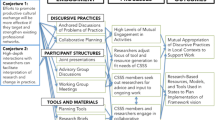Abstract
The Education and Human Resources (EHR) Directorate at the National Science Foundation has been examining its role in supporting the development of new approaches to science, technology, engineering and mathematics (STEM) education. This article explores what it means to be scientifically literate, what it takes to become a learning organization, how the EHR Directorate is working towards becoming such an organization through rigorous self-study, and how EHR can best manage its large portfolio of awards that support investigations in STEM education to enhance their collective value to researchers, policymakers and educators. Several elements of the self-study process are described, and the implications for the Directorate as well as for the field of researchers in science education are explored.
Similar content being viewed by others
References
American Association for the Advancement of Science (1990). Science for all Americans. Oxford University Press, New York.
American Association for the Advancement of Science. (1993). Benchmarks for scientific literacy: Project 2061, Oxford University Press, New York. Retrieved July 12, 2004, from www.project2061.org/tools/benchol/ch1/ch1.htm
Boyer, E. L. (1990). Scholarship Revisited: Priorities of The Professoriate, The Carnegie Foundation for the Advancement of Teaching, Princeton, NJ.
Brown, J. S., and Duguid, P. (1991). Organizational learning and communities-of-practice: Toward a unified view of working, learning, and innovation. Organizational Science 2: 40–57.
Brown, J. S., and Duguid, P. (2000). Balancing Act: How to capture knowledge without killing it. Harvard Business Review 78: 73–79.
Burkhardt, H., and Schoenfeld, A. H. (2003). Improving educational research: Toward a more useful, more influential, and better-funded enterprise. Educational Researcher 32: 3–14.
Downey, G., Hegg, S., and Lucena, J. (1993, June). Weeded Out: Critical Reflection in Engineering Education, Paper presented at the American Anthropological Association, Washington, DC.
Eckel, P., Green, M., and Hill, B. (2001). On change V—Riding the waves of change: Insights from transforming institutions, American Council on Education, Washington, DC.
Eisenhart, M., Finkel, E., and Marion, S. F. (1996). Creating the conditions for scientific literacy: A re-examination. American Educational Research Journal 33: 261–295.
Garvin, D. (1993). Building a learning organization. Harvard Business Review 74: 78–91.
Gregory, J., and Miller, S. (1998). Science in Public: Communication, Culture and Credibility, Perseus Publishing, Cambridge, Massachusetts.
Glassick, C. E., Huber, M. T., and Maeroff, G. I. (1997). Scholarship Assessed: Evaluation of The Professoriate, Jossey-Bass, San Francisco.
Harvard Committee. (1945). General Education in a Free Society, Harvard University Press, Cambridge, MA.
House, E. R., and Howe, K. R. (1999). Values in Evaluation and Social Research, Sage, Thousand Oaks, CA.
Kelly, A. E. (2003). REC Commentary, Unpublished manuscript.
Levitt, N. (1999). Prometheus Bedeviled: Science and The Contradictions of Contemporary Culture, Rutgers University Press, New Brunswick, NJ.
Mark, M. M., Henry, G. T., and Julnes, G. (2000). Evaluation: An Integrated Framework for Understanding, Guiding and Improving Policies and Programs, Jossey-Bass, San Francisco.
Martin, R. R., Manning, K., and Ramaley, J. A. (2001). The self-study as a chariot for strategic change. In Ratcliff, J. L., Lubinescu, E. S., and Gaffney, M. A. (Eds.), How accreditation influences assessment, New Directions for Higher Education, Jossey-Bass, San Francisco, pp. 95–115.
Moschkovich, J. N. (1996). Moving up and getting steeper: Negotiating shared descriptions of linear graphs. The Journal of the Learning Sciences 5: 239–277.
National Science Board Science and Engineering Indicators 2004. (2004) (Two volumes), National Science Foundation, Arlington, VA (volume 1, NSB-04-1; volume 2, NSB 04-1A).
Ramaley, J. A. (2002). Moving mountains: Institutional Culture and transformational Change. In Diamond, R. M. (Ed.), A Field Guide to Academic Leadership, Jossey-Bass, San/Francisco, pp. 59–74.
Shavelson, R. J., and Towne, L. (Eds.). (2002). Scientific Research in Education, National Research Council, Washington, DC.
St John, M. (2004, January). PowerPoint presentation to expert panel of EHR Directorate Mathematics Portfolio Review.
Stokes, D. E. (1997). Pasteur’s Quadrant, Brookings Institution Press, Washington, DC.
Vygotsky, L. S. (1978). Mind in Society. The Development of Higher Psychological Processes. Harvard University Press, Cambridge, MA.
Wenger, E. C., and Snyder, W. M. (2000, Jan/Feb). Communities of practice: The organizational frontier. Harvard Business Review 78: 139–146.
Wenger, E. (1999). Communities of Practice: Learning, Meaning and Identity, Cambridge University Press, Cambridge.
Author information
Authors and Affiliations
Corresponding author
Additional information
The views expressed in this paper are those of the authors and do not necessarily reflect the opinions of the National Science Foundation.
Rights and permissions
About this article
Cite this article
Ramaley, J.A., Olds, B.M. & Earle, J. Becoming a Learning Organization: New Directions in Science Education Research at the National Science Foundation. J Sci Educ Technol 14, 173–189 (2005). https://doi.org/10.1007/s10956-005-4420-8
Issue Date:
DOI: https://doi.org/10.1007/s10956-005-4420-8




